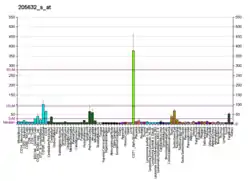PIP5K1B
Phosphatidylinositol-4-phosphate 5-kinase type-1 beta is an enzyme that in humans is encoded by the PIP5K1B gene.[5][6][7]
Abnormal silencing of the PIP5K1B gene contributes to the cytoskeletal defects seen in Friedreich's ataxia.[8]
References
- GRCh38: Ensembl release 89: ENSG00000107242 - Ensembl, May 2017
- GRCm38: Ensembl release 89: ENSMUSG00000024867 - Ensembl, May 2017
- "Human PubMed Reference:". National Center for Biotechnology Information, U.S. National Library of Medicine.
- "Mouse PubMed Reference:". National Center for Biotechnology Information, U.S. National Library of Medicine.
- Pook MA, Carvajal JJ, Doudney K, Hillermann R, Chamberlain S (Jul 1997). "Exon-intron structure of a 2.7-kb transcript of the STM7 gene with phosphatidylinositol-4-phosphate 5-kinase activity". Genomics. 42 (1): 170–2. doi:10.1006/geno.1997.4726. PMID 9177790.
- Carvajal JJ, Pook MA, dos Santos M, Doudney K, Hillermann R, Minogue S, Williamson R, Hsuan JJ, Chamberlain S (Nov 1996). "The Friedreich's ataxia gene encodes a novel phosphatidylinositol-4- phosphate 5-kinase". Nat Genet. 14 (2): 157–62. doi:10.1038/ng1096-157. PMID 8841185. S2CID 6324358.
- "Entrez Gene: PIP5K1B phosphatidylinositol-4-phosphate 5-kinase, type I, beta".
- Bayot A, Reichman S, Lebon S, Csaba Z, Aubry L, Sterkers G, Husson I, Rak M, Rustin P (2013). "Cis-silencing of PIP5K1B evidenced in Friedreich's ataxia patient cells results in cytoskeleton anomalies". Hum. Mol. Genet. 22 (14): 2894–904. doi:10.1093/hmg/ddt144. PMID 23552101.
Further reading
- Niiro H, Clark EA (2003). "Branches of the B cell antigen receptor pathway are directed by protein conduits Bam32 and Carma1". Immunity. 19 (5): 637–40. doi:10.1016/S1074-7613(03)00303-0. PMID 14614850.
- Carpenter CL (2004). "Btk-dependent regulation of phosphoinositide synthesis". Biochem. Soc. Trans. 32 (Pt 2): 326–9. doi:10.1042/BST0320326. PMID 15046600.
- Carvajal JJ, Pook MA, Doudney K, et al. (1995). "Friedreich's ataxia: a defect in signal transduction?". Hum. Mol. Genet. 4 (8): 1411–9. doi:10.1093/hmg/4.8.1411. PMID 7581382.
- Loijens JC, Anderson RA (1997). "Type I phosphatidylinositol-4-phosphate 5-kinases are distinct members of this novel lipid kinase family". J. Biol. Chem. 271 (51): 32937–43. doi:10.1074/jbc.271.51.32937. PMID 8955136.
- Chang JD, Field SJ, Rameh LE, et al. (2004). "Identification and characterization of a phosphoinositide phosphate kinase homolog". J. Biol. Chem. 279 (12): 11672–9. doi:10.1074/jbc.M309721200. PMID 14701839.
- Humphray SJ, Oliver K, Hunt AR, et al. (2004). "DNA sequence and analysis of human chromosome 9". Nature. 429 (6990): 369–74. doi:10.1038/nature02465. PMC 2734081. PMID 15164053.
This article is issued from Wikipedia. The text is licensed under Creative Commons - Attribution - Sharealike. Additional terms may apply for the media files.




